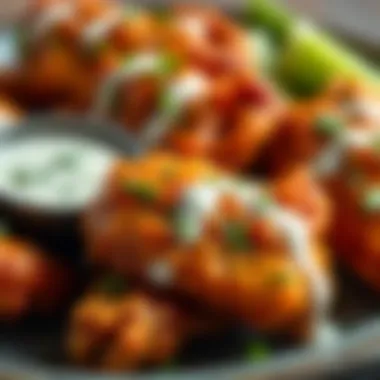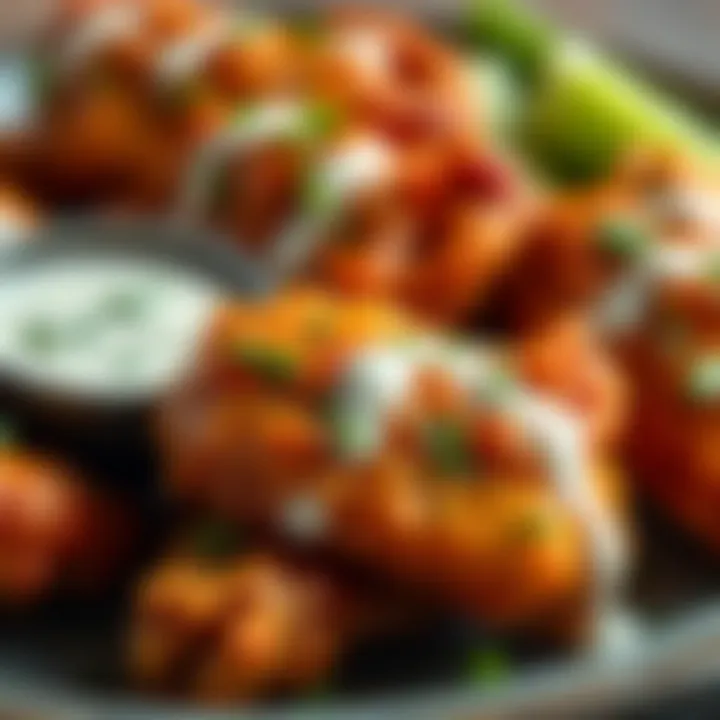Exploring Ranch Dressing Wings: A Culinary Perspective


Intro
Ranch dressing wings have carved a niche in the culinary world, combining two beloved comfort foods into a finger-licking delight. This dish isn’t just another appetizer; it’s a gastronomic experience that reflects a blend of cultural origins and modern cooking techniques. Whether you savor them at your local pub, whip them up for a game night, or serve them at a family gathering, the allure of ranch dressing wings is undeniable.
In this exploration, we will journey through the rich history and preparation methods that make these wings a staple across many dining tables. Understanding the ingredients, cooking techniques, variations, and even the nutritional aspects can elevate your culinary skills and impress your guests. Let’s dive in!
Ingredients Breakdown
Primary Ingredients
The key players in ranch dressing wings are quite straightforward but each brings unique textures and flavors to the table:
- Chicken Wings: The star of the show. You can opt for different cuts like drumettes or flats, depending on your preference.
- Ranch Dressing: A creamy blend of buttermilk, herbs, and spices. The base flavor that idealizes these wings.
- Hot Sauce: For those who like a kick, adding hot sauce can elevate the flavor profile significantly.
Optional Ingredients
While the primary ingredients are essential, here are some optional additions that can take the flavor to another level:
- Garlic Powder: A sprinkle adds depth.
- Paprika: For a hint of smokiness.
- Green Onions: A fresh garnish that brightens the dish.
Essential Kitchen Tools
To create these delicious wings, you’ll need:
- A baking sheet or frying pan
- Mixing bowls
- Tongs for flipping
- Measuring cups and spoons
Step-by-Step Preparation
Prepping the Ingredients
Start by cleaning your chicken wings. Rinse them under cold water and pat them dry with paper towels. This step is crucial as it helps achieve that crispy texture when cooking. In a medium bowl, combine ranch dressing with any optional ingredients you choose to add, creating a marinade.
Cooking Techniques and Methods
There are multiple ways to cook these wings:
- Baking: For a healthier option, toss the wings in the ranch dressing, arrange them on a baking sheet, and bake at 425°F for about 25-30 minutes until golden brown.
- Frying: A traditional method that produces superbly crispy wings. Heat oil to around 350°F and fry the wings until they reach a lovely golden hue.
Assembly and Presentation Tips
To serve ranch dressing wings, place them on a colorful platter, drizzling some extra ranch on top or side, and don't forget those green onions for garnishing. Presentation can make or break the dining experience, so consider serving them with celery sticks and a side of extra dressing.
Dietary Considerations
Gluten-Free Options
If you’re catering to gluten-free diets, ensure the hot sauce and ranch dressing used are gluten-free. Many brands offer this option, making it easy to enjoy by everyone.
Vegetarian and Vegan Substitutes
For those following a vegetarian or vegan diet, consider using plant-based wings made from cauliflower or soy protein. There are also vegan ranch dressings available that can replace traditional ranch without sacrificing taste.
Nutrition Facts & Nutritional Considerations
While these wings are a treat, moderation is key:
- Calories: Typical wings can range from 250 to 500 calories per serving, depending on the cooking method and additions.
- Protein: A good source of protein, packing around 20-30 grams per serving depending on the portion size.
Variations and Customizations
Flavor Enhancements
Feel free to play around with flavors. You can incorporate different sauces like barbecue or teriyaki as a marinade or glaze.
Alternative Cooking Methods
Aside from baking and frying, you can also grill the wings for that smoky flavor. Using a grill is a great way to get that charred crust that many people enjoy.
Pairing Suggestions (Sides, Drinks, etc.)
To complement ranch dressing wings, consider serving:
- Sides such as coleslaw or potato wedges
- Drinks like beer, or a refreshing lemonade
Common Commonly Asked Questionss and Troubleshooting
Frequently Asked Questions
- Can I prep the wings ahead of time?
Absolutely! You can marinate them a few hours before cooking. - What’s the best way to store leftovers?
Store them in an airtight container in the fridge for up to 3 days.
Common Mistakes to Avoid
- Not drying the wings thoroughly can lead to sogginess when cooking.
- Overcrowding the baking sheet or frying pan; ensure enough space to allow proper crisping.


Solutions to Potential Problems
If your wings aren’t crispy: Try raising the cooking temperature or finish them under the broiler for a few minutes.
Preamble to Ranch Dressing Wings
Ranch dressing wings are more than just a dish; they're a culinary phenomenon that brings together flavors, textures, and gastronomic comforts. The appeal lies not only in the taste but also in the cultural associations—wings bathed in creamy ranch dressing evoke memories of gatherings, celebrations, and good times shared with family and friends. Understanding this unique combination allows culinary enthusiasts to appreciate both the simplicity and complexity of ranch dressing wings.
Definition and Characteristics
At its core, ranch dressing wings refer to chicken wings that are typically tossed in a ranch dressing sauce, sometimes after being marinated or even grilled. The delectable creamy ranch complements the crispy or tender chicken, creating a satisfying dish. Characteristically, they present a balmy blend of buttermilk, herbs, and spices, which rounds out the flavor profile perfectly.
The texture is key here; whether they are baked, fried, or grilled, the crispy outer layer pairs elegantly with the smooth ranch coating. This contrast is what makes ranch dressing wings particularly irresistible—crunchy yet creamy, satisfying in every bite. The dish can vary not just in cooking style but also in the level of heat or tanginess, depending on the chosen ranch dressing or seasoning blend.
Historical Context
Understanding the roots of ranch dressing wings provides insight into why they’ve become a staple in American cuisine. Ranch dressing itself was originally concocted in the 1950s by a man named Steve Henson, who created the recipe for the ranch workers on his farm in California. Over the decades, it gained immense popularity, especially after its commercial release in the early 1980s.
Wings, on the other hand, have a rich history that dates back to the 1960s in Buffalo, New York, where the classic Buffalo wing was born. The marriage of ranch dressing and chicken wings emerged as a favored option among diners and party-goers, especially during sporting events and casual get-togethers.
Thus, ranch dressing wings stand at the intersection of history and culinary evolution. They reflect not just a regional taste but also a broader trend towards comfort food that invites social interaction and shared enjoyment. This context enriches their appeal and gives them a prominent place in modern food culture.
"Ranch dressing wings symbolize a blend of creativity and tradition in the culinary world—not just food, but an experience that resonates with shared moments."
Emphasizing the dish's foundational role in many gatherings further illustrates its importance. Whether it’s at a backyard barbecue, a game night, or simple family dinners, ranch dressing wings have marked their territory as a go-to comfort dish that continues to evolve in kitchens everywhere.
Ingredients for Ranch Dressing Wings
When diving into the delightful realm of ranch dressing wings, the ingredients play a pivotal role in the overall outcome of this cherished dish. Understanding the elements involved not only enhances the flavor but can also shape the texture and appeal of the wings. From the choice of chicken to the ranch dressing itself, each component holds significance that can elevate or diminish the final product.
Primary Components
Central to any ranch dressing wings are, of course, the chicken wings. These are typically divided into three parts: the drumette, the flat (or wingette), and the tip. Each part has its own texture and flavor profile, which contributes to the overall enjoyment of the dish. Opting for fresh, high-quality chicken can make a marked difference. When cooked well, wings can be succulent with perfectly crisp skin. Additionally, the ranch dressing itself is arguably the heart of this dish. The traditional blend usually includes components such as buttermilk, mayonnaise, garlic, onion powder, and various herbs. This combination not only adds creaminess but also brings a balance of tang, savoriness, and richness that perfectly complements the wings' flavor.
Selecting Quality Chicken
Choosing the right chicken is crucial for achieving maximum flavor in your ranch dressing wings. Look for chicken wings that are organic or free-range if possible. These options are generally more flavorful and juicier than conventional wings. Also pay attention to the size; larger wings often provide more meat, while smaller ones can have a more profound skin-to-meat ratio, which some folks might prefer for that extra crunch. Checking for signs like an even color and firmness is key; wings should be moist looking but not slimy. If you're lucky enough to find wings that haven't been frozen or treated with additives, you've hit the jackpot. This not only ensures a more flavorful meal but also aligns with healthier eating habits.
Ranch Dressing Variations
Ranch dressing wings thrive on creativity. There’s room to explore various ranch dressing variations that can deepen the flavor profile of your dish.
Homemade Ranch Dressing
Making your own ranch dressing can be a game changer when preparing wings. Homemade ranch typically boasts fresher flavors compared to pre-packaged versions. The beauty of DIY ranch lies in its adaptability; you can tweak ingredients to suit your personal preferences. Moreover, incorporating fresh herbs, like dill or chives, can provide vibrant flavors that store-bought options simply can't match. This ensures a richer and fresher taste that enhances the wings' overall profile. One drawback might be the time involved in making it, but for ardent food lovers, the quality is often worth the effort.
Store-Bought Options
On the flip side, store-bought ranch dressing offers great convenience. Many well-known brands have perfected their recipes, providing a reliable taste that countless people enjoy. Using a ready-to-drink ranch dressing can save precious time, allowing for a quick preparation of wings that are still flavorful. The downside to this option is that they often contain preservatives and additives, which might not sit well with everyone. Yet, there is a vast range of flavors available on the market today, from classic to spicy variations, allowing cooks to experiment with different tastes without any hassle.
"The base of a good dish often lies in the quality of its ingredients. Taking the time to select carefully can reward you with a culinary masterpiece that excites the palate."
When experimenting with ranch dressing wings, your ingredient choices will directly impact the success of your final dish. Whether you stir up some homemade dressing or grab a bottle from the store, the focus should always be on achieving that perfect balance of flavors that makes each bite unforgettable.
Preparation Techniques
When it comes to crafting the perfect ranch dressing wings, preparation techniques play a pivotal role in determining the final flavor and texture of the dish. Properly handling the chicken wings and understanding the cooking methods can elevate this dish from ordinary to extraordinary. Not only do these techniques ensure that the wings are safe to eat, but they also help lock in flavor and maintain moisture, giving a satisfying bite that keeps folks reaching for more.
Marinating the Wings
Marinating the wings is an essential step that should not be overlooked. By soaking the chicken in a marinade composed of ranch dressing, herbs, and spices, you allow the flavors to penetrate the meat. This process typically requires at least thirty minutes but can be left for several hours or even overnight for maximum flavor infusion.
One key consideration is selecting a marinade that complements the ranch dressing. Adding a splash of hot sauce or a hint of garlic can create a more complex flavor profile. Not only does marinating help flavor the chicken, but it also tenderizes the meat, making it more enjoyable to eat. Remember, well-marinated wings have a better chance of standing out at any gathering.
Cooking Methods
The way you cook the wings has a significant impact on the final result. There are various methods to choose from, each lending its own character to the dish. Here’s a closer look at three of the most popular techniques:
Baking
Baking wings is often favored for its convenience and ability to yield crispy skin without excess oil. This method requires preheating your oven and arranging the marinated wings on a baking sheet, generally using parchment for easy cleanup. One notable aspect of baking is that it allows for even cooking—no need to flip halfway through.
Many people appreciate baking as a healthier option, as it significantly reduces the fat content compared to frying. However, a potential disadvantage is that achieving the perfect crispiness might require a little extra time and monitoring. Some folks sprinkle the wings with cornstarch before baking to enhance the crunch.
Frying
Frying chicken wings is perhaps the most traditional method, generating a golden-brown appearance paired with a crunchy surface. This technique is quick, providing crispy wings in under ten minutes if done right. Utilizing hot oil ensures that the wings cook evenly, sealing in moisture and flavor.
The key characteristic of frying is the immediate cooking method where high temperatures cause the moisture to create steam inside the chicken while the oil crisps the outer skin. However, this method uses a significant amount of oil, which can raise the calorie count. Despite this, people often favor frying for that unmistakable, indulgent taste.
Grilling
Grilling chicken wings adds a distinctive flavor from the charred marks and smoky essence. This technique is especially popular during summer barbecues. It involves cooking the wings on a grill, which imparts a crisp exterior while keeping the inside juicy. Grilling offers the advantage of infusing a smoky flavor that’s hard to replicate through other methods.
One thing that stands out about grilling is the flexibility it offers with various marinades and dry rubs. It’s also social—gathering around a grill often turns into a communal event. The downside, however, is the need for close attention to prevent burning, and grilling often requires planned timing so all wings finish together.


Don’t shy away from experimenting with these methods! Each has its peculiar charm and tailors the wings to different culinary preferences.
Flavor Profiles
Understanding the flavor profiles behind ranch dressing wings is key to mastering this beloved dish. When made right, the marriage of the chicken's savory flavors and the creamy, zesty ranch dressing creates a culinary symphony that dances on the palate. Not only does it enhance the wing's taste, but the complexity of flavors also caters to a variety of preferences, making these wings a crowd pleaser.
The essence of flavor profiles can be broken down into various elements that elevate the overall eating experience:
- Balance: Achieving a perfect blend of flavors requires an understanding of how different tastes interact with each other. The tanginess of ranch, for example, cuts through the richness of fried or baked wings, preventing them from feeling overwhelmingly heavy.
- Contrast: Different flavors can either complement or contrast with one another, adding depth to the dish. A hint of spice or an unexpected ingredient like lemon juice can provide that delightful contrast, making each bite more exciting.
- Complexity: Layers of flavors that come together harmoniously create a more satisfying dish. Crafting a ranch dressing that includes herbs, spices, and even a bit of garlic or onion powder enhances its depth.
In the upcoming sections, we will dive deeper into the components of ranch dressing and the additional ingredients that can further enrich these wings.
The Essence of Ranch Dressing
At the core of ranch dressing wings lies, of course, the ranch dressing itself. This smooth, creamy concoction is not only a slathering sauce; it’s a flavor enhancer that brings this dish to life. Traditionally made from buttermilk, sour cream, mayonnaise, and a blend of herbs, the flavor profile of ranch can vary widely based on the recipe used.
One of the key aspects of ranch dressing is its equilibrium of flavors. The creaminess from the sour cream or mayonnaise pairs perfectly with the tang of buttermilk. These primary components create a robust base that serves as the backbone for any additional flavors, whether they be stronger spices or delicate herbs. The infusion of herbs like dill, chives, and parsley gives it a signature freshness, while garlic and onion powder may lend a welcome depth and an almost umami quality.
Furthermore, considering the versatility of ranch dressing is crucial in culinary adaptation. Variations are rampant, with some opting to add hot sauce or other spices to kick up the heat. Understanding these essence elements allows cooks to play with their ranch dressing creations, tailoring them to suit various tastes and occasions.
Complementing Ingredients
The inclusion of other ingredients alongside ranch dressing elevates the wings in not just flavor but also texture and presentation. These complementing elements can make or break the experience.
Spices and Seasonings
Spices and seasonings are the unsung heroes of ranch dressing wings, bringing that extra oomph to the dish. When seasoning chicken wings, it's pivotal to think beyond salt and pepper. Smoked paprika, for instance, introduces a subtle smokiness that rounds out the dish beautifully, while cayenne pepper or red pepper flakes can inject a desirable heat.
The key characteristic of spices is their ability to transform a simple dish into something captivating. Each spice has its own unique feature, like the warmth of cumin or the earthiness of oregano. Here, the advantage lies in creating layers of flavors: when you season the chicken with spices before cooking, it allows the flavors to penetrate and meld into the meat, enhancing each bite.
But there are also disadvantages; over-seasoning can overwhelm the dish. As with many things in cooking, moderation is key. Finding the precise balance ensures that the ranch dressing can still shine through without getting lost in a sea of spices.
Accompaniments
Accompaniments play a pivotal role in giving context to ranch dressing wings. They can change the overall experience of the dish significantly. For instance, serving wings alongside crunchy celery sticks or carrot sticks not only provides a refreshing crunch but also serves as a fantastic palate cleanser. The crispness of fresh vegetables complements the richness of the wings, creating a well-rounded meal.
Another popular accompaniment is dipping sauces. While ranch is already a creamy dipping option, offering sides like spicy aioli or blue cheese dressing can add variety for those who crave a different flavor experience. The unique features of these accompaniments lie in their ability to either contrast or complement the wings in a delightful way.
However, the downside is that too many choices may confuse diners. Keeping it simple yet effective will often yield the best responses, allowing the flavors of the wings and the ranch dressing to take center stage.
Enhancing ranch dressing wings with spices and carefully chosen accompaniments opens up a world of flavor possibilities, ensuring that each serving is not just a meal, but a sensory experience.
Serving Suggestions
When it comes to ranch dressing wings, the way they are served makes all the difference. The presentation and pairing of these wings can elevate the experience from merely eating to genuinely enjoying a meal. This section will explore how the right accompaniments and serving techniques can enhance flavor, texture, and overall satisfaction.
Ideal Pairings
Side Dishes
Side dishes play an important role in a full dining experience, especially when it comes to ranch dressing wings. They contribute not just to the meal's overall flavor but also to its nutritional balance. Classic accompaniments like celery sticks, carrot sticks, or potato wedges are not just popular due to tradition; they also offer a refreshing contrast to the richness of the wings.
Key Characteristics:
- Crunchy Texture: Crunchy veggies like celery add a refreshing crunch that cleanses the palate between bites of the rich wings.
- Nutritional Benefits: A well-chosen side dish can add vitamins and minerals, balancing out the caloric content of the fried wings.
Unique Features:
- Variety and Color: Combining various colors, from bright orange carrots to green celery, makes for a visually appealing plate that invites diners to indulge.
- Flavor Contrast: The mildness of the celery or carrots complements the zesty ranch flavor without overpowering it.
However, it’s crucial not to overdo the sides. Too much heft can overshadow the star of the show: the wings. Opting for light, crisp options is generally a wise choice.
Beverages
The choice of beverages can significantly enhance the experience of ranch dressing wings. Think of drinks as personality traits that can either elevate the character of the meal or clash with it.
Key Characteristics:
- Refreshing Choices: Beverages that are light and crisp, such as lemonade or iced tea, serve as perfect complements. They counter the heavy, creamy texture of ranch dressing beautifully.
- Foamy Options: Beer, especially lighter ales or lagers, can cut through the richness while adding a kick of flavor that works well with all savory dishes.
Unique Features:
- Flavor Schooling: The carbonation in sodas or beer can help cleanse the palate, allowing for a clean taste of wing flavor in between bites.
- Alchohol Pairing: Cocktails made with citrus elements, like a margarita, can offer a zingy counterpoint to the creaminess of ranch dressing.
Yet, it's wise to avoid overly sugary or heavy drinks, as they can mask the taste of the wings. A thoughtfully chosen beverage can enhance enjoyment, lifting the meal to new heights.
Presentation Techniques
Presenting ranch dressing wings artfully can turn a simple dish into a feast for the eyes. A well-plated meal invites the senses and makes the experience more enjoyable.
- Build Layers: Start by placing the wings in a stylish manner, perhaps cascading them over a bed of fresh greens or alongside colorful sides.
- Garnish Creatively: Adding a sprinkle of herbs or a drizzle of gourmet ranch dressing can make a simple plate look gourmet.
- Use Charming Serving Dishes: Consider utilizing rustic wooden boards or elegant platters to enhance the presentation. This can set the tone for the dining experience, making it feel more special and thought out.
With these serving suggestions, ranch dressing wings can become a centerpiece at any gathering, creating not just a meal but memorable moments.
Cultural Significance


Ranch dressing wings have transcended the realm of mere food; they embody a cultural staple that resonates deeply in various social settings. On the one hand, they reflect culinary creativity, merging traditional chicken wing recipes with the familiar and creamy taste of ranch dressing. On the other hand, they encapsulate bonding experiences shared during communal gatherings, elevating their status beyond just sustenance.
Regional Variations
In America, ranch dressing wings have adopted various interpretations depending on the region. For example, in the Southern United States, some folks prefer their wings tossed in a vibrant homemade ranch blend, incorporating fresh herbs like dill and chives harvested from backyard gardens. In contrast, the West Coast often gravitates towards a creamier consistency with added garlic powder, making every bite a dreamy indulgence. It's this diversity that allows ranch dressing wings to be embraced across borders while still holding true to their playful spirit.
Popularity in Culinary Contexts
Ranch dressing wings serve as a versatile centerpiece, particularly resonating in the context of gatherings and celebrations.
Barbecues and Gatherings
During barbecues, ranch dressing wings shine through sheer adaptability. The smoky flavors from the grill mesh well with the creamy, tangy notes of ranch, creating a delightful flavor symphony. This aspect makes them a extremely favorable choice for large gatherings. Guests can snag a wing on-the-go, making them perfect finger food. Their accessibility helps create an inviting atmosphere, encouraging mingling and conversation.
The unique feature of these gatherings is the casual vibe, where formalities take a back seat. People are drawn together by food, and ranch dressing wings help set the stage for relaxed enjoyment, making them a true barbecue favorite.
Sports Events
Sports events, too, buzz with the energy of ranch dressing wings. Here, they serve not just as snacks but as part of the collective experience that fans endure together—sharing laughter, cheers, and sometimes, heated debates over which team will claim victory.
One key characteristic of wings at sporting events is their ability to keep hands busy—in between bites, fans stay animated, engaged in the thrill of the game. This makes ranch dressing wings a go-to choice as they manage to combine finger food with the excitement of the event itself.
However, it’s worth noting that while these wings are widely enjoyed at sports gatherings, they can often attract messiness. The drizzled ranch and splattering sauces make it necessary to have extra napkins at hand. Still, it’s this very nature that contributes to the shared camaraderie and the light-hearted spirit of the community.
Ranch dressing wings, through these regional nuances and varied contexts, become much more than just a dish. They represent celebration, connection, and culinary innovation—elements that form the crux of why they hold such a cherished place in our hearts.
Nutritional Considerations
Understanding the nutritional aspects of ranch dressing wings is essential not just for enthusiasts but for anyone looking to maintain a balanced diet. It presents a chance to combine enjoyment with mindfulness, appreciating the flavors while considering health impacts. From caloric content to potential modifications, comprehending these elements allows for healthier choices without sacrificing taste.
Caloric Content
When diving into caloric content, ranch dressing wings are a mixed bag. Depending on their preparation, the calories can stack up quickly. For instance, a typical serving of traditional wings coated in ranch dressing might range from 600 to 800 calories. This figure can shift drastically based on various factors like cooking method and portion sizes.
Consider the impact of frying as opposed to baking. Fried wings absorb additional oil, inflating their caloric value. In contrast, baking tends to retain fewer calories while still delivering tempting crunch. Furthermore, ranch dressing itself can add roughly 100 calories per tablespoon, so a generous dip can escalate your overall intake.
Healthier Modifications
Low-fat Ingredients
A practical approach to tackle caloric content is through low-fat ingredients. Substituting regular ranch dressing with a low-fat version significantly reduces calories and fat without compromising flavor too much. These dressings use modifications—like non-fat buttermilk or yogurt—as bases, maintaining a creamy texture that pairs well with chicken wings.
Adopting low-fat ingredients not only helps in cutting down calories but also promotes heart health. With less saturated fat, you might feel less guilty indulging in those tasty wings while keeping your overall dietary goals in check. However, it’s vital to keep in mind that flavor profiles, although similar, might be slightly altered, so sampling different brands or homemade recipes can yield delightful surprises.
Alternative Cooking Methods
When it comes to preparing ranch dressing wings, alternative cooking methods play a pivotal role in both flavor and health. Methods like grilling or air frying are emerging as game-changers, effectively reducing the amount of oil needed compared to traditional frying. Grilling infuses a smoky flavor that juxtaposes beautifully with the tangy ranch, while air frying crisps up the wings without submerging them in oil.
These methods tend to conserve the inherent flavors of the chicken itself, allowing ranch dressing to enhance rather than mask them. As a result, you get healthier wings that are equally enjoyable. If you're looking for an uncomplicated way to add a nutritious twist to your meal, switching things up with these cooking methods might be your best bet.
In summary, understanding nutritional considerations adds depth to the culinary experience of ranch dressing wings. Balancing indulgence with healthy choices contributes to a well-rounded enjoyment for all food lovers.
Common Mistakes and Solutions
When preparing ranch dressing wings, there are common pitfalls that can lead to disappointing results. Understanding and addressing these mistakes is crucial for anyone looking to master this delicious dish. By being aware of what can go awry, cooks can not only salvage a meal but also elevate the overall experience. Having a few strategies in mind to circumvent these likely errors can go a long way toward ensuring your wings come out just right.
Overcooking or Undercooking
One of the biggest missteps in cooking wings is the fine line between overcooking and undercooking. Undercooked wings can pose health risks, particularly due to harmful bacteria like Salmonella. Conversely, overcooked wings turn into dry, tough morsels that lack the juicy goodness that is expected. To strike the right balance, it’s essential to monitor the cooking time and temperature.
Aim for an internal temperature of at least 165°F, but many chefs recommend targeting 175°F for optimal tenderness. A meat thermometer is your best friend here. When baking, grilling, or frying wings, be sure to check them periodically to avoid slipping into either of these undesirable realms. A simple visual cue can also help: look for crispy skin and juices running clear instead of pink.
Remember: Cooking is less about strict timelines and more about observing the food.
Another wise move is to remove the wings from heat just before they reach the expected internal temperature and allow them to carry over cook for a few more minutes while resting. This approach helps retain moisture and achieve that desired texture that everyone craves.
Inadequate Flavoring
Flavoring ranch dressing wings correctly is an art. Some cooks make the mistake of overlooking this vital step, leading to bland wings that fail to impress. The strength of flavor can diminish during the cooking process, so it’s important to not skimp on seasonings and marinades. A rich ranch dressing cannot simply be slathered on at the end; it requires a little preparation and thought.
To enhance flavor, consider the following tips:
- Marinate the Wings: Letting the wings soak in a marinade for several hours or even overnight can infuse them with depth and complexity. The ranch dressing itself, combined with extra herbs, spices, garlic, or even hot sauce, can create a robust profile.
- Season Generously: Before cooking, sprinkle salt, pepper, and other spices generously. This acts as a preliminary flavor barrier that keeps the wings interesting.
- Layer Flavors: Adding a bit of ranch seasoning or dry rub prior to cooking can give that extra kick when layered with the dressing after.
It's important to keep tasting and adjusting as you go, not just at the final stages. A splash of vinegar or lemon juice can also brighten flavors, cutting through the richness and enhancing the overall experience. Ultimately, balancing flavors ensures each bite bursts with that recognizable ranch appeal, making for a satisfying dish that pleases all pallets.
Closure
Ranch dressing wings exemplify the beautiful intersection of flavor and culture within the culinary landscape. These delectable bites have carved out a unique niche in the realm of comfort food, offering not only a satisfying blend of taste but also a social connection among those who enjoy them. The preparation and serving of ranch dressing wings are timeless, yet they invite innovation and distinction, prompting food lovers to engage with the dish on personal terms.
Recap of Key Points
Throughout this exploration of ranch dressing wings, several key aspects have been underscored:
- Defining Characteristics: Ranch dressing wings marry the rich, creamy flavor of ranch dressing with the crispy delight of chicken wings, creating a dish that appeals to a wide array of palates.
- Historical Context: The origins of ranch dressing have roots that tie back to the mid-20th century, evolving into a staple condiment that pairs beautifully with various foods.
- Preparation Techniques: Different cooking methods—whether baking, frying, or grilling—provide a spectrum of textures and tastes, catering to personal preferences.
- Flavor Profiles: The essence of ranch dressing couples with complementing ingredients, spices, and accompaniments, enhancing the overall taste experience.
- Cultural Significance: Ranch dressing wings play a prominent role in social gatherings, barbecues, and sporting events, fostering a sense of community.
- Nutritional Considerations: While delicious, understanding the calories involved and considering healthier modifications can help balance enjoyment with health.
Encouragement to Experiment
With the foundational insights gathered, there lies vast potential for culinary exploration. Experimenting with ranch dressing wings opens doors to unique adaptations. Mixing in diverse herbs or experimenting with spice levels can yield new flavor profiles. Moreover, swapping chicken for alternative proteins like cauliflower or tofu can cater to various dietary preferences and introduce innovative plant-based options.
By suggesting modifications and tweaks, one pushes the boundary of this dish, creating personal flair and enhancing the enjoyment derived from each bite. Therefore, dive into your kitchen, gather your ingredients, and unleash your creativity in crafting the perfect ranch dressing wings to share with friends or enjoy solo. After all, cooking is not just a routine task; it's a thrilling adventure waiting for you to embark on.







